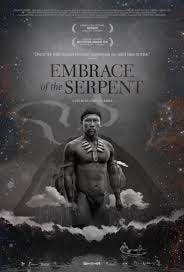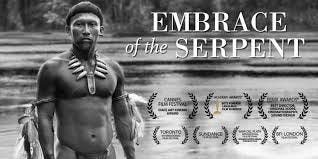A humble suggestion: Next time you’re about to watch an Ayahuasca documentary on Youtube, check out the 2015 film Embrace of the Serpent instead.
If you can sit through it, you will have gained a first-rate education in the history of colonization in the Americas, including the scientific appropriation and colonization of sacred plant medicines. But viewer beware: this film is not for the faint of heart. Or stomach. It’s a bit like the experience of drinking Ayahuasca, as a matter of fact.
The first several times I tried to watch Embrace of the Serpent, I couldn’t get through the opening scenes, which depict an anaconda giving birth. Like rattlesnakes, anacondas give live birth. As someone who was plagued with snake nightmares for most of my life—until I started using psychedelics, in fact—I found those images startling, unbelievable, almost too intense to watch. But Ciro Guerra’s genius doesn’t stop there. The entire film is a psychedelic renaissance gut check.
I daresay you should watch before you drink.
The film follows the shaman Karamakate as he tries to help two white explorers seeking plant medicine in the Columbian Amazon during two journeys separated by 30 years. Karamakate makes the first journey as a young man, and the second as an elder. Ambivalent about helping the white men who seek him out, Karamakate burns the plant they’re lusting over as a young man, making a mind-bending statement about the impossibility of preserving indigenous plant medicine in the face of colonization. As an elder, the shaman decides to use the plant to prepare medicine for the second white explorer, facilitating the man’s psychedelic journey. Nevertheless, even after the brew alters the explorer’s perception of the world, the plant’s future remains uncertain at the end of the film. Although the plant the men seek is fictional, it bears many similarities to Ayahuasca.
As the white explorers travel with Karamakate, they encounter their own colonial brutality at every turn. The explorers and their guide find themselves marooned in a Spanish Catholic Mission where boys are beaten for speaking their language and observing their customs. The priests who run the place have gone crazy, seduced by power and isolation into believing they themselves are Messiahs. These scenes are even more gut wrenching than the live snake birth at the beginning of the film because of their uninhibited violence and cruelty, sanctioned in the name of Christianity.
In other words: If you come to Ayahuasca still laden in Catholicism or Christianity in general, you have A LOT of work to do. The church continues to be instrumental in destroying Native American belief systems and plant knowledge. If you don’t believe me, spend a little bit of time on a reservation in the United States, where missionary colonialism is still alive and well. (See my previous post here: The Psychedelic English Teacher and the Rez Baller.) Attempting to secularize plant medicine and prove its benefits via science does little to confront or heal this history and, in fact, deliberately elides and suppresses it. The Messiahs of the psychedelic renaissance don’t typically like talking about all that messy stuff, although even Rick Doblin has embraced a mild form of reciprocity these days.
Embrace of the Serpent emphasizes the fusion between Christianity, scientific exploration and the destruction of people and nature in the Amazon when the explorers meet a cripple assigned to watch tapped rubber trees in a plantation. When Karamakate gets angry and dumps out a bucket of raw rubber, the cripple, who has already had one arm chopped off, begs to be killed, fearing the rubber barons will torture him. The rubber barons have made the man and the trees into slaves. Karamakate wants the white explorer to understand his connection to this exploitation, but the man is ill-equipped. Later, Karamakate discovers part of the explorer’s mission is to find a disease-resistant type of rubber tree to begin the cycle of exploitation all over again.
Guerra’s choice to shoot the film in black and white distills the violence of the colonial encounter in South America, and works against white audience’s propensity toward exoticizing the landscape and people in my view. The director gave an interview in 2016 in which he said the choice to use black and white reflects the fact that the Amazon in the film is an imagined place, and creates a world where the viewer cannot distinguish between plant, animal or human on the basis of color. “If I had been forced to film in color, I would have preferred not to do it,” he said. Guerra Interview
If you care to delve into the colonial legacies you’re engaging in by seeking out medicines like Ayahuasca, Embrace of the Serpent is my top film recommendation.




